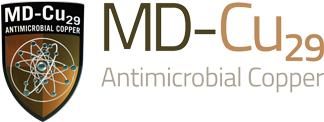
FAQs

FAQs
What is MD-Cu29?
MD-Cu29 antimicrobial copper is antimicrobial; in other words, it kills bacteria*. Various studies have shown that antimicrobial copper is one of the only metals that has been proven to kill 99.9% of bacteria* within 2 hours of exposure1.
Which bacteria does MD-Cu29 antimicrobial copper kill?
Studies have shown that, within two hours of contact, MD-Cu29 antimicrobial copper kills greater than 99.9% of the following1: Vancomycin-Resistant Enterococcus faecalis (VRE), Staphylococcus aureus, Enterobacter aerogenes, Escherichia coli O157:H7 (E. coli O157:H7), Pseudomonas aeruginosa and Methicillin-Resistant Staphylococcus aureus (MRSA).
How quickly does MD-Cu29 antimicrobial copper work?
MD-Cu29 antimicrobial copper kills 99.9% of disease-causing bacteria* within two hours of contact1.
How can MD-Cu29 antimicrobial copper be used?
Using copper material on high touch areas in hospitals and homes (such as door knobs, sinks or wall plates) can help reduce the amount of disease causing bacteria*—thereby reducing the amount of bacteria communicated through the touch of a surface1.
How does copper kill pathogens?
Copper, in high doses, kills bacterial* cells. While the exact mechanism is still under research, several studies have indicated that the free ion in copper attacks the membrane of a bacterial cell thus killing it.
Does an MD-Cu29 antimicrobial copper surface need to be cleaned?
Antimicrobial copper does need to be cleaned regularly; it’s designed as a supplement to other hygiene practices. In other words, you still need to wash your hands! And copper can be cleaned like any normal metal surface in your space1. Just be sure not to wax, paint, lacquer, varnish or otherwise coat MD-Cu29 antimicrobial copper, or it will lose its effectiveness.





